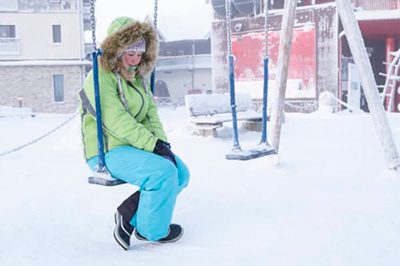
Fall slump. The winter blahs. Is it almost spring?
Weather can have an impact on our daily mood and feelings. For some people, too many gray days can cause a case of “the blues.”
Factors other than weather also can bring on seasonal depression. For example, in the holiday and post-holiday months, financial debt, too many commitments, weight gain, and/or broken resolutions can lead to Seasonal Affective Disorder (SAD) or “winter depression.”
Around 11 million Americans suffer from SAD. Up to four times as many women suffer from winter depression or SAD as men; and those living in Canada and the northern United States are up to eight times more likely to suffer from SAD than people living in the southern U.S. where the sun shines more in the winter months.
Sufferers may exhibit symptoms commonly associated with depression including:
- Feelings of hopelessness and worthlessness

- Thoughts of suicide or suicidal actions
- Loss of interest in activities
- Withdrawal from social interaction
- Sleep and appetite problems
- Difficulty with concentrating and making decisions
- Decreased sex drive
- Lack of energy
- Agitation
Treating Winter Depression
Depression treatments can vary. However, according to the Yale School of Medicine, one of the unique ways SAD is treated is through the use of a lightbox, where exposure to a “10,000 lux light box for 30 to 45 minutes” is given at a consistent time each morning.
According to the Mayo Clinic, “light therapy mimics natural outdoor light and appears to cause a change in brain chemicals linked to mood.” The Mayo Clinic urges people to work with their doctors on the type of lightbox to use, the length of time to use it, and the time of day when it would be most effective for you.
Additionally, some changes in your environment can help. The Mayo Clinic suggests:
- Make your home, work and other places brighter. Natural light can help – so open the curtains and sit closer to the window.
- Get into the Great Outdoors. Even if it is cold, a quick morning walk can help improve your mood throughout the day. If it is warm enough, consider sitting outside (even on cloudy days!).
- Get moving. Regular exercise and physical activity help alleviate anxiety and stress.
Another method of treating SAD and winter depression is traditional antidepressants. Doctors may often go through a lengthy trial-and-error process to find medication that works well for their patients.
Pharmacogenomics is changing this process. In addition to a comprehensive patient evaluation, clinicians may use pharmacogenomics to help inform their medication selection. Pharmacogenomic tests (like the GeneSight test) analyze clinically important genetic variations that may impact how patients metabolize and respond to medications commonly prescribed to treat depression, anxiety, ADHD and other psychiatric conditions.
Winter depression doesn’t have to keep you indoors and isolated. Check with your healthcare provider to see if the GeneSight test is right for you.
For more information about winter depression and SAD, please see our infographic here or read these articles:
Combating SAD: Can Physical Activity in Winter Help?
Seasonal Affective Disorder (SAD) Has These Known Symptoms
Tips to Cope with Seasonal Affective Disorder (SAD)

Our articles are for informational purposes only and are reviewed by our Medical Information team, which includes PharmDs, MDs, and PhDs. Do not make any changes to your current medications or dosing without consulting your healthcare provider.
The GeneSight test must be ordered by and used only in consultation with a healthcare provider who can prescribe medications. As with all genetic tests, the GeneSight test results have limitations and do not constitute medical advice. The test results are designed to be just one part of a larger, complete patient assessment, which would include proper diagnosis and consideration of your medical history, other medications you may be taking, your family history, and other factors.
If you are a healthcare provider and interested in learning more about the GeneSight test, please contact us at 855.891.9415. If you are a patient, please talk with your doctor to see if the GeneSight test may be helpful.




